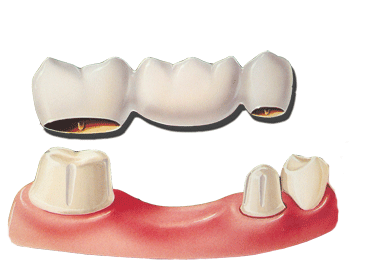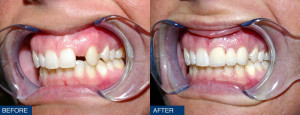Replacement of Missing teeth
Fixed Bridge
Teeth can also be replaced with a fixed bridge if there are teeth in the area that are adequate in number and sufficiently healthy and strong to support the artificial teeth. In order to fabricate a bridge, the adjacent teeth are prepared by reducing their size (or cut down) to remove all the enamel, making room for the prosthetic tooth restoration. A prosthetic tooth (or teeth) can be suspended between adjacent teeth in this way to provide a functional and cosmetic replacement for the missing tooth.

The limitation of this form of treatment has to do with the irreversible preparation of the adjacent (abutment) teeth for support. This exposes them to the risk of trauma to their nerves, raising the risk of requiring root canal treatment. Long-term, fixed bridges between natural teeth have an average life expectancy of 10-12 years before requiring replacement. Replacement of fixed bridges often entails further treatment as the abutment or supporting teeth have been further compromised over time by advancing dental disease (such as cavities or periodontal bone loss).
Dentures
Removable partial or full dentures can replace a single missing tooth, several teeth, or all of the teeth in your upper and/or lower jaw. Dentures rely on support by the other teeth in that jaw (for partial dentures) and from mechanical support by the remaining ridge of gum and underlying bone. Maxillary (upper jaw) full dentures also may be helped by suction between the denture and the underlying gum of your palate (roof of mouth).
Reasons for replacing a missing tooth (or teeth) vary and should be weighed against the risks of leaving the space, as well as resultant changes that may take place in the rest of your dentition.

